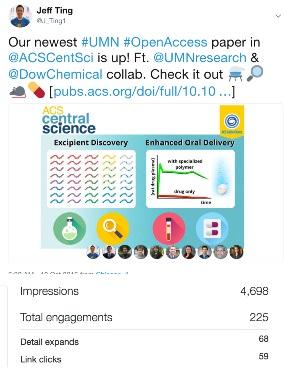by Jeffrey M. Ting
Early in my chemical engineering career, the importance of networking for career development was emphasized in classrooms, workshops, and seminars. At the time, I didn’t fully appreciate what this advice really meant. Networking with colleagues is much more than exchanging business cards – at a career fair, for example, recruiters are likely inundated with hundreds of these, diluting a one-time, brief exchange into an ocean of introductions, elevator pitches, and conversations. At its core, professional networking is about building enduring relationships with people whose valuable skill sets, experiences, and goals can match and complement each other in mutually beneficial and unexpected ways. Chemical engineers are universal problem solvers working in diverse fields; networking offers an interface with a wider array of technical experts and managers as allies, which may lead to new opportunities and even full-time jobs.
However, depending on your employment environment, financial constraints, and geographical location, the prospect of networking can be challenging and time-consuming. The advent of the Internet has, in some sense, democratized traditional barriers to participation with an audience of employers, fellow peers, and the general public at large. Scientists and engineers can access collaborators, industry leaders, and even Nobel Laureates with a few clicks.
For this article, I will focus on how online platforms can be unique avenues to network by (1) building visibility of your abilities and (2) facilitating productive engagement in whichever community you are a part of (Figure 1). Perhaps more importantly, the appropriate use of such strategies to enhance your reputation can provide a competitive advantage as technology and digital communication continue to evolve. There are many excellent resources for further readings; a few of my personal favorites that have influenced my outlook are provided below.1-4

Figure 1. Online platforms offer the ability to network by building visibility of your background, skills, and goals in alignment with breakout opportunities. It also offers the ability to engage and communicate what you are passionate about with employers, colleagues, and citizens.
Visibility.
Figure 2 shows demographic information on the use of social media over time in the U.S. from Pew Research Center.5 The percentage of adults that use at least one social media site has risen from 11% in 2006 to 69% today. Among increasingly younger age groups this growth is even higher; the future U.S. STEM workforce will grow up with the Internet being a pervasive and crucial part of their everyday lives in how they learn, think, and communicate. Adapting to this changing landscape with a visible, online presence can be a powerful tool for building lifelong relationships.

Figure 2. Breakdown of the percentage of U.S. adults that use at least one social media site from 2006 to 2018, (A) by total and (B) by age. Data from the Pew Research Center, 2018.5
It is important to balance online visibility with an appropriate degree of self-promotion. Create your virtual identity from the standpoint of exchanging knowledge, career interests, and honest credentials that may lend themselves to solve someone’s problem. Overall, aim to present your value and authenticity to your online community.
Productive Engagement.
A major aspect of social media involves creator-generated content that is interactive for a broader audience. LinkedIn is the most prominent website / mobile app service for networking,. Similar to a resume or CV, this platform allows you to showcase your strengths, experiences, and metrics of success in a professional manner. Keeping an updated online profile is especially important if you are seeking a job. For instance, Chiang and Suen have shown that recruiters make inferences about an applicant’s job/organization fit and hiring recommendations in various perception categories after viewing their LinkedIn profiles.6
Beyond LinkedIn, Twitter also offers the ability to interact immediately with a network of professionals. Companies promote new initiatives and advertise their products to customers. Academics have cultivated various online ecosystems to stay informed, connect with diverse engineers and scientists, and engage in scientific communication, such as the #RealTimeChem and #ScicComm hashtags. Academic publications are also regularly shared among scientific fields. Figure 3 shows a Tweet linking to one of my papers along with its reach/impact. This example highlights how accomplishments can be shared and immediately disseminated across research communities as printed scientific journals become less common.

Figure 3. Example post from Twitter promoting the publication of a research article.7 Viewing the Tweet activity provides data such as platform impressions or audience engagement.
Altogether, online platforms can provide remarkable ways to initiate and establish mutually beneficial partnerships for professional careers. Self-presentation can be a powerful tool in career development as young chemical engineers. Take advantage of the resources on online platforms at your school and through professional organization –your online reputation could be the key to open real-world doors!
Jeffrey M. Ting, Ph.D., is a NIST-CHiMaD Postdoctoral Fellow at the University of Chicago Institute for Molecular Engineering. He was recently inaugurated into the 2018 Class of Future Faculty Scholars by the American Chemical Society Division of Polymeric Materials: Science and Engineering. You can reach him by email at jting1@uchicago.edu, through LinkedIn at linkedin.com/in/jting1, and on Twitter at @J_Ting1.
References
(1) Hoffman, R.; Casnocha, B. “The Start-up of You: Adapt to the Future, Invest in Yourself, and Transform Your Career” 1st ed.; Crown Business, New York, NY, 2012.
(2) McCarthy, C.; Maclachlan, J. “Improving your Social Chemistry: Science Communication on Facebook, Twitter and Other Online Platforms” 2018, https://www.acs.org/content/acs/en/acs-webinars/professional-development... (accessed Oct. 10, 2018).
(3) Levine, A. G. “Networking for Nerds: Find, Access and Land Hidden Game-Changing Career Opportunities Everywhere” 1st ed.; John Wiley & Sons, Inc.: Hoboken, NJ, 2015.
(4) Daly, B. “A Tale of Two Layoffs – One Chemical Engineer's Networking Odyssey” 2010. www.aiche.org/chenected/2010/06/tale-two-layoffs-one-chemical-engineers-... (accessed Oct. 10, 2018).
(5) Pew Research Center, “Social Media Fact Sheet” 2018, http://www.pewinternet.org/fact-sheet/social-media/ (accessed Oct. 10, 2018).
(6) Chiang, J. K.-H.; Suen, H.-Y. “Self-Presentation and Hiring Recommendations in Online Communities: Lessons From LinkedIn” Comput. Hum. Behav. 2015, 48, 516–524.
(7) Ting, J. M.; Tale, S.; Purchel, A. A.; Jones, S. D.; Widanapathirana, L.; Tolstyka, Z. P.; Guo, L.; Guillaudeu, S. J.; Bates, F. S.; Reineke, T. M. “High-Throughput Excipient Discovery Enables Oral Delivery of Poorly Soluble Pharmaceuticals” ACS Cent. Sci. 2016, 2, 748–755.
- Log in to post comments
